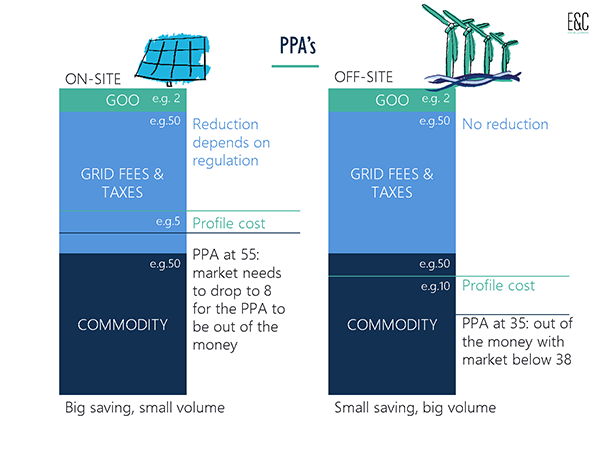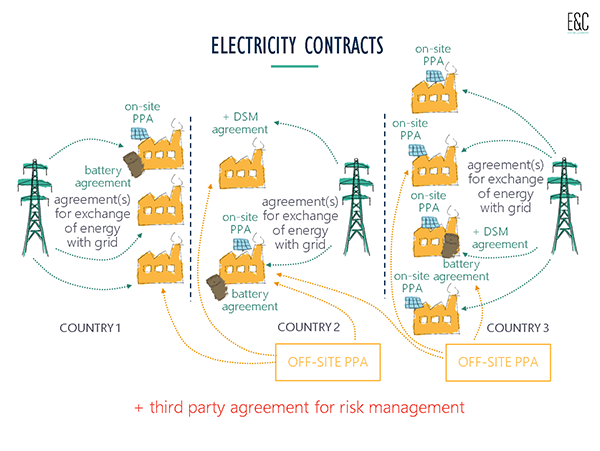By Dina Karamarko on 27/03/2019
Topics: Sustainable Energy Management
Since we negotiated our first wind turbine projects back in 2007, the landscape has changed quite significant. Sustainable energy management has become an indispensable part integrated in all of our services carried out by each of our consultants. Since 2015 Dina Karamarko is with the E&C team with a special passion for our work in sustainable energy procurement. Let’s ask Dina how she experienced the last years.
Yes, definitely, both from a client as from a consultant’s point of view. In the past we saw quite some resistance and scepticism towards sustainable energy procurement, often because of a lack of knowledge. But now, hardly any conversation about energy procurement goes by without having a constructive discussion about the opportunities regarding sustainable energy.
Our clients are realizing that sustainable energy procurement is no longer an additional cost, but that it can also add value. They want it to be part of their future energy procurement.
Clients aren’t only interested in guarantees of origin, but also in other sustainable solutions. In most cases, power purchase agreements make a good business case, even in countries where there are no subsidies in place. Recently, we launched a tender in Spain to have solar panels installed on the roof of one of our clients. Even with the fact that we had to include some extra charges for capacity, it was still a good business case and our clients gave its go for the project.
Just to be clear, the deployment of sustainable energy still depends on the needs of each client. At some companies, the decision making is still defined by cost, or compliance, but an increasing number of companies integrates sustainability in its procurement strategies and long-term goals. They want to be part of initiatives such as the RE100, or ‘One Planet Thinking’ (WWF).
I always like to say, the choice of energy procurement is actually very simple: you either stay grey, or go green. However, the deployment of the latter option has many applications, or shades of green.
The easiest and often the cheapest option to make your energy procurement more sustainable is by acquiring guarantees of origin. These are tracking instruments that label and provide information on electricity often coming from hydro and biomass sources. But be careful. Often these GOs are brought in connotation with greenwashing because it’s possible that you’re only paying a surcharge for GOs coming from a hydroplant that already exists for 50 years. And yes, the investment for it, is already paid off for a long time.
Depending on the appetite of the client, and auditing needs, an option could be also to go for guarantees of origin of locally produced wind, or solar. These usually come with a price premium but do result in extra green capacity being added to the grid which isn’t the case with the ones described above.
In general, guarantees of original are great if there is no other option of making your energy procurement more sustainable. For a company, this just means a repetitive cost on a yearly basis.
Second option could be a power purchase agreement. On-site, or off-site power purchase agreements are often great alternatives that actually come with a return on investment. In addition, having PPAs can result in affordable energy, security of supply, and contribute to achieving your sustainability goals. These can range from brand recognition to carbon emission targets.
 Energy buyers are sometimes a bit reluctant because they fear the impact that renewables could have on their portfolio. Should they be?
Energy buyers are sometimes a bit reluctant because they fear the impact that renewables could have on their portfolio. Should they be?Let’s start by saying that not every form of sustainable energy procurement fits each client’s needs and the impact of it differs as well. You first need to be aware of your current energy procurement situation to be able to sketch the path towards a more sustainable future.
But indeed, having more renewables can affect the energy consumption profile, current and future electricity contracts, or have an impact on the non-commodity part of the energy bill. The solution isn’t far fetched: discuss this with your consultant and add enough flexibility conditions to your contract when launching a tender to make sure that there’s no hurdle to deploy any renewable solution now or in the future.
Currently, not every client’s portfolio is as complex but in the course of the ongoing energy transition we can expect energy procurement contracts to be paired with battery agreements, demand side management, guarantees of origin, onsite PPAs, offsite PPAs and cross-border PPAs.

Keep this in mind when organizing your tenders and looking for the best solution that will bring you a step closer to your sustainability goals.
They’re sometimes called synthetic power purchase agreements or virtual power purchase agreements. Let me first explain you how a regular offsite PPA works in order to clarify the difference. In case a company in Brussels would like to consume electricity generated by an offshore windturbine park in the North Sea, the electricity is added to the grid via an entry point in Zeebruges for example and is extracted via an exit point in Brussels for which this company needs an agreement with the grid distributors. In a cross-border PPA set-up, a company sets a goal to green 30% of its global energy consumption and they look for one project developer that can put this volume on the grid anywhere in the world. Once the electricity is produced by this PPA, it’s immediately resold to the local market and the company still buys the volume they need in the separate countries where they need it through regular contracts. They physically don’t receive this green energy but they do contribute in greening electricity by adding it to the grid in exchange of the electricity they consume locally.
You see, there’s plenty of options to contribute to a more sustainable environment but you do need to score each on of them based on the specifics of your business.
Feel free to leave a comment and share our blog posts on social media!
E&C is an energy procurement consultancy with an international team of energy experts that offer a unique blend of global capabilities and local expertise.
Our offices in Europe, the US and Australia serve more than 300 clients from South-Africa to Norway and Peru to Australia that have an annual spend between 1.5 million and 1.5 billion dollars.
E&C Consultants HQ
Spinnerijkaai 43
8500 Kortrijk
BELGIUM
+32 56 25 24 25
info@eecc.eu
